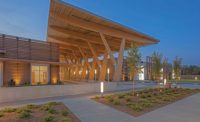Design-Build: Ready to Meet the Economic Challenges of 2009
Despite the economic challenges that 2009 presents, the design-build project delivery method is on track to meet and best serve customers and their projects more than any other project delivery method in the construction marketplace.

BLOXEM
President Obama’s economic stimulus plan offers significant funding for new vertical and horizontal design and construction projects throughout Texas. The bill contains about $140 billion in construction spending nationwide, according to the Southwest. AGC of America.
How is design-build uniquely qualified for the stimulus bill spending requirements? National research and past experience proves design-build will put these projects out faster and leaner than other methods of delivery in the marketplace.
The Austin-based Construction Industry Institute conducted a national study of project delivery methods (based on more than 350 projects nationwide) and concluded design-build is:
- 12% faster for construction than design-bid-build (or D-B-B, a traditional method)
- 33% faster for delivery of design and construction process than D-B-B
- 5% less in a project’s “cost of growth” despite change orders than D-B-B
Public officials, charged with spending the stimulus funds, will be seeking experienced design-build firms to get these projects under way quickly. It is time, therefore, to position true design-build firms to compete and offer knowledgeable, professional design-build practices to these potential clients in the public sector.
The marketplace has a lot of “bandwagon firms” that advertise themselves as design-builders. Unfortunately, some of these so-called design-build firms have little experience, little professional knowledge and, few, if any, recognized industry credentials.
How does one identify a truly qualified design-build company from the so-called bandwagon firm? The client should seek:
- a company with an established history of design-build projects
- a company that has been a member of the same team involved in numerous design-build projects
- a company with a record of projects similar to that sought by the client
The firm’s history must demonstrate that its past projects were completed on time and within budget and showed innovation in design, materials and products. If this process were done correctly, the owner will have a new building that it could afford at the level of quality originally presented.
A true design-build firm will have established affiliations with design-build industry associations such as the Design-Build Institute of America. The firm will have a working knowledge and experience with design-build contract agreement groups such as the DBIA, American Institute of Architects and Associated General Contractors. The same companies will have recognized professionals on staff, such as DBIA’s Designated Design-Build Professional credential. The industry-recognized certification alone requires extensive design-build project experience, completion of educational courses, a certification test and owner references before the designation is granted.
At its core, design-build is a method of project delivery in which one entity, referred to as the design-builder, forges a single contract with the owner to provide architectural, engineering and construction services. The design-builder accepts full responsibility and accountability for these three services, and, from the beginning, works with the owner as part of a fundamentally true “team” effort.
The team works to pursue design quality, respect budgets, control costs and schedule and assure that a successful program – from conception to completion – is consistently achieved on the building project.
It is important that the team consists of competent, experienced and dedicated professionals, joined together in a business, to provide the highest quality and most effective construction products and services to the client. The knowledge and skills of the assembled team members are continually enhanced for the good of each individual, the company and the client.
It is critical to the overall success of any building program that the team members have a high level of mutual trust throughout the planning and construction process.
Another key component of success is that the selected design-build team has a long-term successful track record of working together with owners of all types of public facilities. Teaming together for just one specific project is not ideal.
The Design-Build Institute of America says the use of design-build contracting for non-residential design and construction in the United States has grown from 5% in 1985 to 45% in 2009. The traditional design-bid-build contracting method has declined from 82% in 1985 to 45% in 2009.
The Texas Legislature didn’t authorize alternative contract delivery methods, including design-build, for school districts until 1997. Today, however, all Texas governmental entities may use design-build.
The increasing number of projects using design-build will continue to grow due to the fact that it is faster, less costly, reduces or virtually eliminates change orders, is preferred by insurance companies and significantly decreases adversarial relationships among the owner, architect, engineer and builder.
It is clear that the overwhelming, positive attributes the design-build brings to a project will move public officials in significant numbers to adopt design-build for 2009 stimulus projects. The urgency of spending the project dollars set forth in the legislation, putting the unemployed back to work and building within the pre-set budgets will position the “true” design-build firm to be a primary player in the 2009 and future marketplace.


